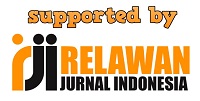FLUKS GAS METAN (CH4) PADA BUDIDAYA PADI SECARA SYSTEM OF RICE INTENSIFICATION DAN KONVENSIONAL PADA SAWAH PASANG SURUT, LEBAK DAN BERIRIGASI
Abstract
ABSTRACT
The research was conducted at fresh water swamp, tidal swamp and irrigated Rice field.Fresh water swamp and Tidal swamp located countryside Betung, subdistrict Pulau Rimau and Sako, subdistrict Rambutan, Regency Musi Banyuasin. While irrigated lowland rice countryside at 0mangunhardjo, Subdistrict Purwodadi, Regency Musi Rawas, from June through October 2010. The research was aimed to knowing and comprehend or understand with to decreased fluxe and emission methane produced and compared with three ecosystem lands cultivated S.R.I. The split plot design was appllied in the research. The treatment main plot consisted of lowland rice (T) with three factors: fresh water swamp (T1), Tidal swamp (T2) dan Irrigated rice field ( T3) and sub plot cultivated (S) there were two factors: convensional (K) and S.R.I (S). The result showed that the rice cultivated S.R.I can decreased of flux methane 40-71% and in the form of emission of gas metan one growing season plant may decrease 19-53 %. Being emang three ecosystem may decrease 61-66 %. Measurement of methane gases emission for the three ecosystem rice field to each other every a period of growth showed the declaned at the age 8 week after planting. Later then the total emission of methane increased before harvest.
Key Word: Convensional, Flux and Emission, Fresh Water Swamp, Methane, SRI, Tidal swamp.
Keywords
Full Text:
PDFReferences
DAFTAR PUSTAKA
Anas, I., A. Kassam., A. Mishra, Rupela, O.P., Thakur, A.K.,Thiyagarajan, T.M., and Uphoff, N. 2010. The system of rice intensification (SRI) as a beneficial human intervention into root and soil interaction. Paper for First International Conference on Soil and Roots Engineering Relationship (LANDCON1005)- Ardebil,Iran 24-26 May,2010.
Ardi, F. 2009. Emisi gas metan (CH4) dan nitro oksida (N2O) pada budidaya padi system of rice intensification. (SRI) di desa nagrak sukabumi. Skripsi Fakultas Pertanian Institut Pertanian Bogor. Bogor (Tidak di publikasikan).
Bouwman, A.F. 1990. Exchange of greenhouse gases between terrestrial ecosystems and the atmosphere. In Bouwman AF (Ed.), Soils and the Greenhouse Effects. John Wiley & Sons, Chichester, New York, Brisbane, Toronto, Singapore.
BPS. 2009. Produksi padi rata-rata nasional 2009. http://webcache.googleusercontent.com Diakses tanggal 25 November 2010.
Hasan, M. 2007. Peningkatan produksi tak melulu bangun irigasi baru. Media Informasi Sumber Daya Air, April-Mei 2007.
Hou, A.X., Chen, G.X., Wang, Z.P., O. Van Cleemput., and Patrick, W.H. Jr. 2000 Methane and nitrous oxide emissions from a rice field in relation to redox and Microbiological Procesess. Soil Sci. Soc. Am. J. 64: 2180 – 2186.
Husin, Y.A., D. Murdiyarso, M.A.K. Khalil, R.A. Rasmussen, M.J. Shearer, S. Sabiham, A. Sunar, H. Adijuwana. 1995. Methane flux from Indonesian wetland rice: The Effects of Water Management and Rice Variety Chemosphere 31(4):3153-3180.
Husny, Z., Gofar, N., Sabaruddin., Marsi., dan Anas, I. 2010. Emisi gas metan dan nitrous oksida serta hasil padi yang ditanam dengan metode SRI dan konvensional di rumah kaca. Makalah disajikan pada Simposium dan Seminar Nasional Tanggal 13-14 Desember 2010 di Palembang.
Hutabarat, T.R., Anas.I., Idris.K., Sugiyanta. 2011. Po lasi mikrob tanah, emisi metan dan produksi padi pada enam kombinasi aplikasi pemupukan dengan budidaya padi SRI. PPs. IPB Bogor
Kartikasari, R. 2007. Petunjuk teknis pengambilan dan analisis sampel gas N2O. Balai Penelitian Lingkungan Pertanian. Balai Besar Litbang Sumberdaya Lahan Pertanian. Badan Penelitian dan Pengembangan Pertanian. Departemen Pertanian.
Lelieveld, J., and P.J.Crutzen. 1993. Methane emissions into the atmosphere, an overview. In Van Amstel AR (Ed.), Methane and Nitrous Oxide, Methods in National Emissions Inventories and Options for Control. Proc. Intern. IPCC Workshop. Netherlands, 3-5 February 1993, pp.17-25.
Mutakin, J. 2010. Budidaya dan Keunggulan Padi Organik Metode S.R.I (System of Rice Intensification ) http://www.noscenter.com/bt3.html diakses 2- 12-2010
Naharia, O., Saeni.M., Sabiham.S., Burhan.S. 2005. Teknologi Pengairan dan Pengolahan Tanah Pada Budidaya Padi Sawah untuk Mitigasi Gas Metana (CH4). Berita Biologi 7(4) : 173-180.
Patrick, W.M Jr., and Reddy C.N. 1978. Chemical changes in rice soils. In IRRI, Soil and Rice. IRRI, Los Banos, Philippines. pp. 361-379.
Rudd, J.W.N and Taylor CD. 1980. Methane cycling in aquatic environments. Adv. Aq. Microbiol. 2:77-150.
Suprihati, 2007. Populasi mikroba dan fluks metana (CH4) serta Nitrous Oksida (N2O) pada tanah sawah : pengaruh pengelolaan air, bahan organik dan pupuk nitrogen. Disertasi. Sekolah Pasca Sarjana.Institut Petanian Bogor.
Sutaryat, A. 2008. Sistem Pengelolaan Pertanian Ramah Lingkungan dengan Metode System of Rice Intensification(SRI).
Uphoff, N., and E. Fernandes. 2003. Sistem intensifikasi padi tersebar pesat. Terjemahan Salam. Htt://www,leisa index.php?url=getblok.php&o.id=67237 & aid =211 7a seq=0 [23/10/2010].
Uphoff, N., S. Rafalaby, and J. R. Drassana. 2002. System of rice intensification. Cornell University.
Uphoff, N., Sato, S., dan Anas, I. 2008. The system of rice intensification (SRI) Seminar Direktorat Jendral Tanaman Pangan Departemen Pertanian dan Ina-SRI, IPB 13 Juni 2008. di Jakarta.
Wiharjaka, A. 2004. Mewaspadai emisi gas nitro oksida dari lahan persawahan. Pusat Penelitian Pencemaran Lingkungan Pertanian Jakenan. Pati.
Yang, S.S., Chung, L.M., Lai, C.M., dan Liu, Y.L. 2009. Estimasi dan methane nitrous oxide emisi dari sawah dan dataran tinggi selama 1990-2000 di Taiwan. 11 hal. http://translate.googleusercontent.com/translate-c?hl=id&langpair. Diakses tanggal 03 Juli 2010.
Zehnder, A.J.B., and Stumm. W. 1988. Geochemistry and biogeochemistry of anaerobic habitats. In Zehnder AJB (Ed.), Biology of Anaerobic Organisms. John Wiley & Sons, Chichester, New York, Brisbane, Toronto, Singapore. pp. 1- 38.
DOI: http://dx.doi.org/10.33512/j.agrtek.v2i2.645
Refbacks
- There are currently no refbacks.
Copyright (c) 2016 Jurnal Agroekoteknologi
INDEXED BY:
View My Stats

This work is licensed under a Creative Commons Attribution 4.0 International License.










